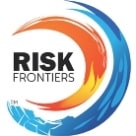Earthquakes in Australia can strike without any prior warning, posing a serious risk of causing loss of life and significant structural damage.
Most of Australia’s largest earthquakes, with magnitudes of 5.6 or higher, have occurred in less populated, remote, or offshore areas, resulting in minimal damage. However, significant destruction was caused by two notable exceptions: the 1968 Meckering earthquake and the 1979 Cadoux earthquake, both of which occurred in densely populated areas. Interestingly, the smaller earthquakes have historically led to more damage across Australia. This is because they are more frequent and tend to occur in areas with higher population densities.
Remarkably, two relatively minor earthquakes, the 1989 Newcastle earthquake with a magnitude of 5.42 and the 1994 Ellalong earthquake with a magnitude of 4.71, account for about 90% of all earthquake-related losses in Australia, despite the Newcastle earthquake being only the 16th largest in the country’s recorded history.
Most of Australia’s capital cities, such as Sydney, Canberra, Melbourne, Adelaide, Perth, and Darwin, have higher seismic hazard levels than the rest of the country due to their proximity to potentially active geological faults.
QuakeAUS Model Overview
QuakeAUS is a national earthquake model for Australia. It uses an earthquake forecast derived from a spatially smoothed distribution of historical seismicity, and a ground motion prediction model developed specifically for Australia. Ground motion amplification uses an Australia-wide soil site classification. Damage is calculated using the full building response spectrum for residential, commercial and industrial property. In addition to calculating losses from earthquake shaking, it also calculates losses from soil liquefaction.
QuakeAUS incorporates data from Geoscience Australia’s National Seismic Hazard Assessment (NSHA18), including revision of the earthquake magnitudes in the Australian Earthquake Catalogue, and the spatially smoothed seismicity model is derived from this catalogue. It also contains a set of active faults derived from the NSHA18 National Fault Source Model, and uses information from NSHA18 to model soil classification and amplification.
Using a 15,000 year event set within a Monte Carlo simulation framework, RF’s QuakeAUS5 calculates Probable Maximum Losses (PML) as a function of Average Return Interval (ARI) or Annual Exceedance Probability (AEP) throughout Australia. The model handles residential, commercial and industrial portfolios and calculates building, contents and business interruption losses.
QuakeAUS Features
Spatially smoothed source model
Risk Frontiers staff developed a spatially distributed earthquake source model for Australia,and Risk Frontiers staff participated in the development of the Somerville et al. (2009) ground motion prediction models with are specifically for Australia.
GMPEs specifically developed for AU
Risk Frontiers staff contributed to Geoscience Australia’s NSHA18, incorporating their earthquake source model and Somerville et al.’s (2009) ground motion predictions, while participating in expert elicitation for model selection.
capacity spectrum method
To estimate losses, QuakeAUS uses the capacity spectrum method, with fragility curves that are derived from building-specific capacity curves for a wide range of building construction types and vintages, and from event-and-site-specific broadband response spectra.
Who can utilise QuakeAUS?
Insurers/Reinsurers
QuakeAUS can calculate earthquake catastrophe risk based loss estimates for property exposure providing valuable insight into whole of portfolio analysis and informing risk based pricing.
Emergency Response
Risk Frontiers personnel have first hand experience with major earthquake events, offering valuable insights into lifeline interdependencies critical for effective emergency response planning.
Utilities
Risk Frontiers is familiar with the utility systems that operate in Australia and can obtain scenario-based estimates of losses from events that impact distributed utility systems.
QuakeAUS Technical Specifications
Hazard Resolution |
Variable resolution grid, down to 1.6km |
Exposure Resolution |
Location Address Level |
Event Catalogue |
50,000 years of stochastic earthquakes |
Ground Shaking and Exposure Parameters |
Location, full acceleration demand spectrum, soil type, building construction type, building age, building height. |
Line of Business |
Residential / Commercial / Industrial |
Business Interruption |
Residential ALE / Commercial BI / Industrial BI |
Coverage |
All Properties on mainland Australia and Tasmania. 100% GNAF |

Behnam Beheshtian, Risk Engineer
Learn More About QuakeAUS
Get the opportunity to speak with the team who developed the QuakeAus model.
Briefing Notes
Read our latest research
Delve into the insightful articles on climate risk and resilience from the team of risk scientists at Risk Frontiers.
Roman concrete 2: Discovery of the chemical processes could lead to the commercialisation of Roman-inspired hot-mixed concrete mixtures
Roman Concrete 2: Discovery of the chemical processes could lead to the commercialisation of Roman-inspired hot-mixed concrete mixtures Jacob Evans In 2018 Risk Frontiers published
Hurricane Helene: The significance and destruction
Hurricane Helene: The significance and destruction Jacob Evans, Risk Frontiers Hurricane Helene was the strongest hurricane (tropical cyclone) on record to strike the Big Bend
How much longer will the Muswellbrook earthquake swarm last
How much longer will the Muswellbrook earthquake swarm last Paul Somerville The ongoing Muswellbrook earthquake swarm (Risk Frontiers, 2024, Briefing Note 503) has now continued
